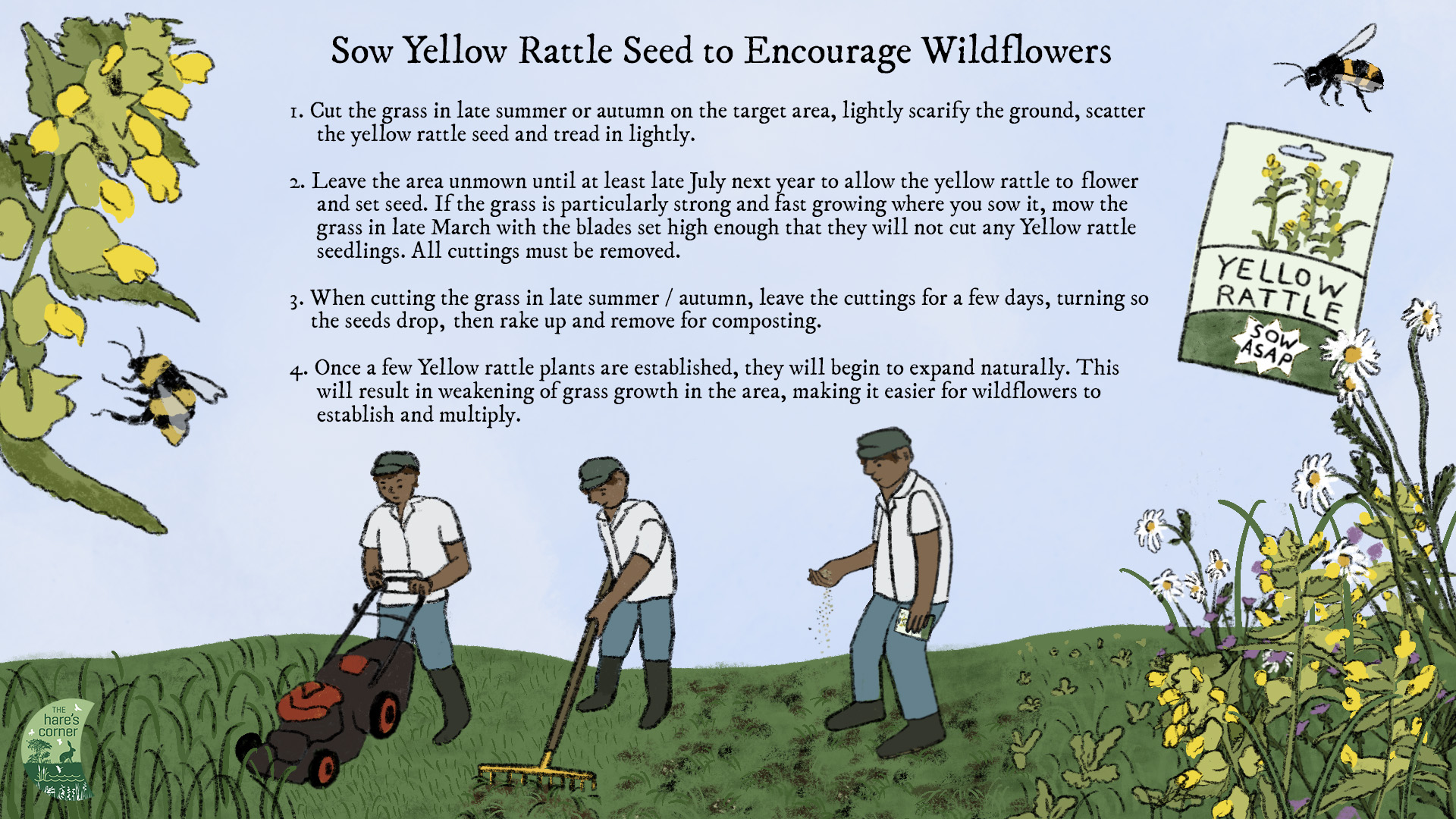
Sow Yellow Rattle Seed to Encourage Wildflowers
Yellow rattle is a semi-parasitic plant that can weaken grass growth, making it easier for wildflowers to establish and multiply.
Where:
- Anywhere there is grass that you would like more wildflowers to grow in – lawns, grassland areas, grassy verges.
- Yellow rattle generally does better in sunny, well drained areas with low fertility.
- Start by selecting a few target areas in which to sow the seed; with the right management it will self-seed and spread over time.
- If possible, choose target areas where grass growth is weaker, less dense and already has a greater variety of wildflowers growing in it. You can pick out the latter by looking for areas with a greater variety of leaf shapes.
When: In late summer through autumn (August – October) and as soon as possible after you get the seed.
Which:
- You can buy Yellow rattle seed from sources such as Burrenbeo Trust who collect it from a field in the Burren and sell it in autumn. Or you can collect it yourself from land where it grows if you have the permission of the landowner.
- If buying from sources other than Burrenbeo, make sure it is guaranteed Irish seed i.e. not just grown here, but originating from Irish seed and not that imported from another country.
- If collecting seed yourself, wait until mid-July / early August when the ripe seed pods are turning brown and beginning to split open. Pull a few plants (don’t worry, they are annuals so grow from seed each year) and tip them upside down in a bucket or paper bag. Leave somewhere dry for a few days, shake the stems to maximise seed drop and then store in an open container or paper bag until sowing.
How:
- Yellow rattle does not store well and needs a period of chilling over the winter to germinate well, so sow as soon as possible after getting it.
- Cut the grass on the target area and lightly scarify the ground to create some bare soil amongst the grass. Scatter the Yellow rattle seed and tread in lightly. Do not cover the seed with soil, it germinates better if not buried.
- Leave the area unmown until at least late July to allow the Yellow rattle to flower and set seed. As Yellow rattle is an annual (i.e. flowers, produces seed and plant dies in a year, with all new plants growing from seed dropped the previous year), it is easy to eradicate it by cutting it too early.
- However, if the grass is particularly strong and fast growing where you sow it, the Yellow rattle seedlings can be shaded out and die before they have the chance to establish and start weakening the grass. Only if this is the case, help it to establish by mowing the grass in late March with the blades set high enough that they will not cut any Yellow rattle seedlings that have germinated. All cuttings must be removed.
- When cutting the grass in late summer/autumn, leave the cuttings for a few days, turning so the seeds drop, then rake up and remove for composting. Once the Yellow rattle and other flowers are established, they will begin to expand naturally.
Care for Yellow rattle: Correct sowing of Yellow rattle needs to be accompanied with the right grass mowing regime to help create a wildflower meadow. See our page ‘Create a Wildflower meadow’ for more info on this. Using commercial wildflower seed packets or seed bombs are not recommended! The best source of wildflower seeds is your local soil seed bank or by collecting seeds from the local area yourself. When established, Yellow rattle can help other wildflowers to germinate and multiply.
Benefits: Yellow Rattle can help to create, and speed up the development of, grasslands rich in wildflowers. Wildflower-rich grasslands are extremely important for wildlife – they provide food for insects, birds and small mammals, improve soil biodiversity, and can store 500% more carbon than fields dominated by one grass species.
Further info
- Meadow-Guideline-2023-WEB.pdf (pollinators.ie)
- Reduced-Mowing-Infographic-WEB.pdf (pollinators.ie)
- Collecting and using wildflower seed – https://pollinators.ie/wp-content/uploads/2022/12/Pollinator-Seeds-How-to-Guide-2022-WEB.pdf